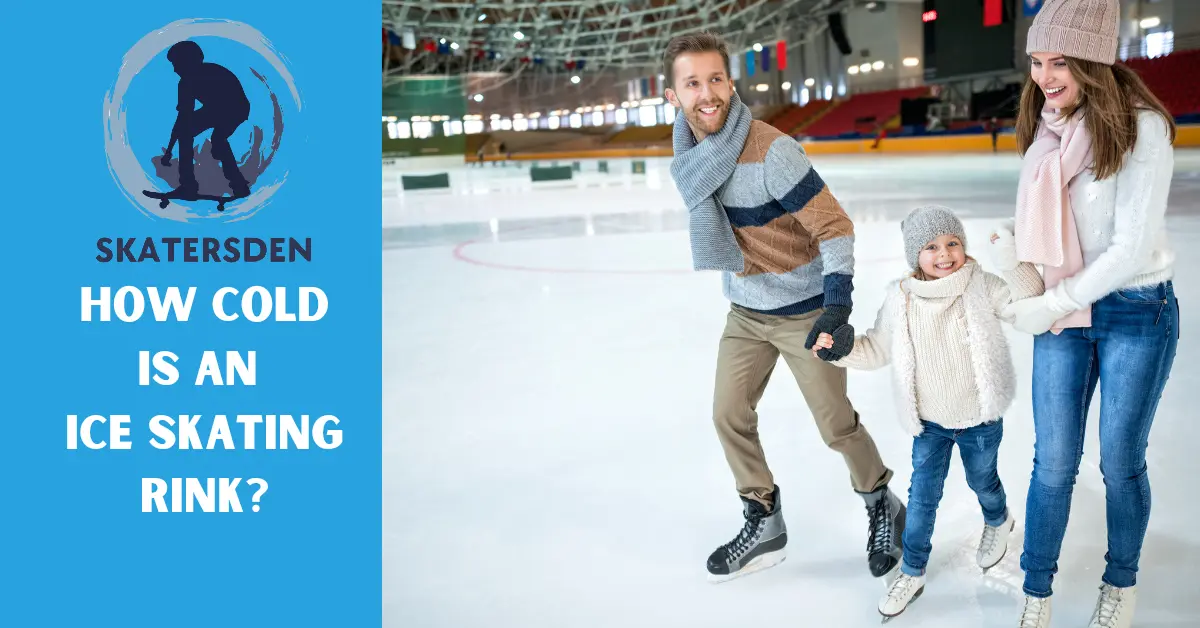Have you ever wondered how cold is an ice skating rink? Or why the ice doesn’t melt even in warmer temperatures? If you enjoy ice skating or are just curious about the science behind it, this is the perfect read for you! Believe us, we have got you covered with our personal experience combined with all the information and facts about ice skating rinks.
How Cold Is An Ice Skating Rink?
Ice skating is done on ice and the ideal temperature for ice to freeze is around 34F degrees or 1.1C degrees. This doesn’t mean that every ice skating rink is maintained at this exact temperature.
Most ice rinks will keep the air temperature from 55 to 65 degrees Fahrenheit or 12.7 to 18.3 degrees Celsius. This temperature range is comfortably cool for skaters and spectators. The on-ice temperature, however, is maintained between 17 and 29 degrees Fahrenheit or -8.3 and -1.6 degrees Celsius. This is significantly colder than the air temperature and is essential for maintaining the solid state of the ice. This results in a surface that is smooth and perfect for skating.
If we talk about indoor ice skating rinks, they often require slightly different conditions compared to their outdoor counterparts. Due to their controlled environment, indoor rinks often maintain their ice at a colder temperature. For optimal skating conditions, indoor rinks typically keep the ice temperature between 18F and 24F degrees, which is equivalent to -7.7C to -4.4C degrees. This lower temperature range aids in preserving the ice quality, providing a consistently smooth and solid surface ideal for various ice skating activities.
Why Doesn’t The Ice Melt?
Melting ice is a fascinating aspect to consider when discussing ice skating rinks. You might think the ice should melt easily, especially in indoor facilities with relatively mild ambient air temperature. But in reality, maintaining the ice’s solid state involves a clever combination of science and technology.
The magic starts with the refrigeration system beneath the surface of the rink. This system circulates a chilling solution, usually glycol, in pipes under the ice. The glycol absorbs heat from the ice, preventing it from melting. It is like an air conditioner for the rink, but instead of cooling the air, it cools the ice.
During periods of heavy usage, such as a packed public skate or a high-intensity hockey game, the system may need to work harder to maintain optimum ice conditions. This approach and the building’s climate control system keep the ice nice and solid, ready for your skating enjoyment.
Read more: Best Ice Skate Bags To Buy!
Does It Have To Be Cold To Ice Skate?
This is another common question among ice skating enthusiasts. The answer is yes, but not necessarily outdoors. As mentioned earlier, indoor rinks can maintain colder temperatures compared to outdoor ones. This means that even on a warmer day, you can still enjoy ice skating indoors without worrying about the ice melting or becoming too soft for skating.
On the other hand, outdoor rinks rely more on natural factors such as ambient air temperature and humidity levels to maintain the ice’s frozen state. As a result, outdoor rinks may not be able to operate in warmer climates or during periods of heavy rainfall. However, with proper maintenance and technology, some outdoor rinks can withstand milder temperatures, allowing for more extended periods of skating fun.
What To Wear For Ice Skating?
Now that we have discussed the optimal conditions for ice skating let’s talk about the essential gear you need to have a safe and enjoyable skating experience. Some of the must-haves include:
- Skate boots: Investing in a good pair of ice skates is the first step. The boots should be comfortable, providing good ankle support, and the blades should be well-maintained and sharp.
- Thermal clothing: Due to the cold environment in the rink, thermal clothing is a must. Layering is recommended, starting with thermal underwear, a light fleece, and a warm jacket.
- Gloves: A pair of waterproof gloves will keep your hands warm and protect you in case of a fall.
- Socks: Opt for thermal socks that wick away excess moisture and provide additional warmth.
- Helmets: A helmet can protect from potential head injuries, especially for beginners.
- Knee and elbow pads: These can be very helpful, especially for beginners, to protect against common injuries during falls.
How Cold Is An Ice Skating Rink: Final Words
So, the average temperature of an ice skating rink is around 32F degrees or 0C degrees, but the actual ice surface can be much colder. We hope this read has answered some of your questions and given you a better understanding of the science behind ice skating rinks. Remember to dress appropriately and have fun on the ice!
Let us know in the comments if you still have any questions left.
Goodbye & Keep Skating Like A Pro With SkatersDen!
Frequently Asked Questions
Q: Are ice rinks always frozen?
Yes, ice rinks are typically kept frozen at all times. Both indoor and outdoor rinks use sophisticated refrigeration systems to maintain the ice surface at a freezing temperature. This ensures optimal conditions for ice skating, regardless of the weather or time of day.
Q: How do I dress for an ice skating rink?
Dressing for an ice skating rink should focus on warmth and flexibility. Layer your clothing starting with thermal underwear, followed by a light fleece and a warm jacket on top. Wear thermal socks and waterproof gloves, and don’t forget protective gear like helmets and pads.
Q: What is the ideal temperature for ice skating?
The ideal temperature for ice skating varies depending on whether it is an indoor or outdoor rink. Indoor rinks typically maintain their ice between 18F and 24F degrees (-7.7C to -4.4C), while outdoor rinks rely on natural factors such as ambient air temperature and humidity levels to keep the ice frozen.
